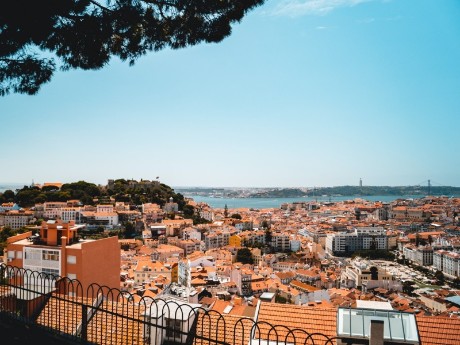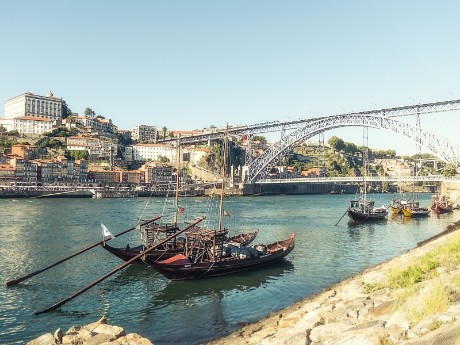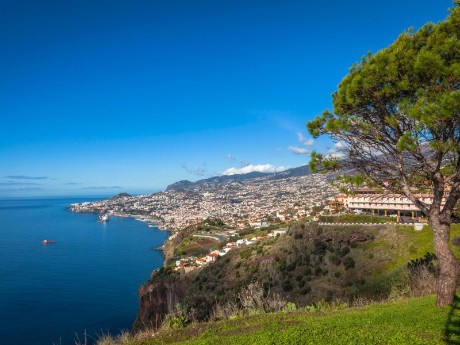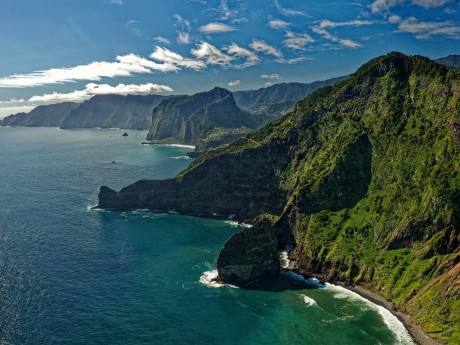Portugal: Lisbon, Porto & Madeira
Embark on a captivating journey to Portugal, where the enchanting city of Lisbon, the picturesque island of Madeira and Porto's riverside Ribeira district beckon with their unique charm. Beginning in Lisbon, explore the charming streets of this vibrant city, visit the iconic Belem Tower, wander through the Alfama district, and take in the breathtaking views from the hilltop São Jorge Castle. Next, make your way to Porto, famous for its port wine and historic center.
Read more
Embark on a captivating journey to Portugal, where the enchanting city of Lisbon, the picturesque island of Madeira and Porto's riverside Ribeira district beckon with their unique charm. Beginning in Lisbon, explore the charming streets of this vibrant city, visit the iconic Belem Tower, wander through the Alfama district, and take in the breathtaking views from the hilltop São Jorge Castle. Next, make your way to Porto, famous for its port wine and historic center. Visit the colorful Ribeira district, stroll along the Douro River, and explore the magnificent Palacio da Bolsa. Enjoy a wine-tasting experience in one of the local cellars, savoring the flavors of Portugal's signature drink. Escape to paradise on the island of Madeira for pure relaxation and bliss. Explore the historic Funchal Old Town and immerse yourself in the vibrant colours of the Monte Palace Tropical Garden. Go dolphin and whale watching or stroll along the Marina, where you can savour delicious seafood in waterfront restaurants while enjoying the picturesque sunset over the Atlantic Ocean. Waterviews strives to offer accommodation options within walking distance of water and/or in an area of touristic interest. Our prices include taxes (but excludes local tourist taxes). Customize your trip to your personal preferences with optional activities (hit the “Add Activities’’) or change hotels, etc. Contact us for customization at no extra cost at: Service@waterviewstravel.com
Destinations
- Lisbon
- Porto
- Funchal
Itinerary
Lisbon

Portugal’s capital city is vibrant, authentic and charming, with its brightly coloured tiled houses lining the steep streets and a riverfront perfect for spending sunny afternoons. From the cobbled and winding streets of Alfama and the majestic castle which overlooks the city to the historic monuments of Belem, Lisbon has it all. Climb one of the seven hills for a panoramic view of the city, listen to Fado music in one of Alfama’s traditional restaurants and don’t forget to sample the ‘Pastel de Belém’.
Read more
Portugal’s capital city is vibrant, authentic and charming, with its brightly coloured tiled houses lining the steep streets and a riverfront perfect for spending sunny afternoons. From the cobbled and winding streets of Alfama and the majestic castle which overlooks the city to the historic monuments of Belem, Lisbon has it all. Climb one of the seven hills for a panoramic view of the city, listen to Fado music in one of Alfama’s traditional restaurants and don’t forget to sample the ‘Pastel de Belém’.
Additional Information
Lisbon is built on seven hills, so getting around Lisbon can be a workout. Many slopes and few really flat areas is one of Lisbon's trademarks. This is also a city of enchanting contrasts: The elegant squares, broad avenues, monumental buildings and rectangular layout of the lower areas quickly gives way to the hilly, narrow, winding, unpredictable and cramped streets of districts such as Alfama and Bairro Alto. The elegant dining rooms and smart rooftop bars of expensive hotels seems like a different world compared to the excellent restaurants disguised behind an inconspicuous façade in a modest Bairro Alto street. Quality patisseries and restaurants thrive side by side with late night bars and noisy discos. The old, tiny squeaky trams (one of the city's trademarks) are no less of a contrast to the efficient metro network.
The Portuguese capital is often perceived as less frantic than other million cities, and traffic and barkers are less aggressive than in many other tourist destinations.
History
According to legend, Lisbon was founded by the mythical Greek hero Odysseus, during his travels home from Troy. However, most historians believe that the city was founded around 1200 BC by Phoenician settlers, utilizing the calm and fresh waters of Tagus river and the proximity to the sea. The Phoenecian name of the city is Alis-Ubo, meaning "safe harbour". Eventually it became part of the Carthaginian Empire. After the Punic Wars, it became the main trading hub of the Roman province Lusitania, under the name Felicitas Julia Olisipo, later Olisipona. During the decline and fall of the western Roman Empire, the Iberian peninsula was invaded by Vandal and Visigothic tribes.
In 711, Lisbon was captured by Muslim forces. During this period, the Castle of São Jorge was expanded. Much of the Moorish heritage is preserved in the nearby Alfama, the oldest standing district of the city. In 1147, a Crusader army en route to the Holy Land helped King Afonso I conquer Lisbon and return it to Christian rule. After the completion of the Portuguese Reconquista some hundred years later, Lisbon was made the capital of Portugal.
Golden Age
The Golden Age of Portugal, and consequentially Lisbon's history, started in the 15th century. In 1415, the young prince Henry "the Navigator" conquered Ceuta, thereby establishing the first European overseas colony. He later founded the Sagres school of navigation in the Algarve region and thereby sparked the age of discovery. During the reign of King Manuel I "the Fortunate" (1495–1521), Portuguese navigators found a way around the Cape of Good Hope, and Vasco da Gama eventually found the Cape Route to India, thereby ending the Venetian monopoly over European-Far Eastern trade. King Manuel gave his name to the "Manueline" architectural style, of which the Tower of Belém in western Lisbon is probably the most well-known example. On marrying princess Isabella of Aragon, Manuel I ordered the conversion or expulsion of the Jewish and Muslim populations. The Portuguese colonial empire grew steadily through the centuries, and eventually came to include the Azores and Madeira in the Atlantic; Brazil in South America; Angola, Cape Verde, Ceuta, Guinea Bissau, Ivory Coast, Mombasa, Mozambique, São Tomé e Príncipe and Zanzibar in Africa; Ceylon, East Timor, Flores, Formosa, Goa, Hormuz, Macau, Malacca and Moluccas in Asia. The Portuguese Oriental trade led to the establishment of the Japanese port city of Nagasaki in 1571.
Decline
With the loss of heirless young king Dom Sebastião in 1578, Portugal enters into a period of succession crisis. By 1580 the Portuguese nobility keen to avoid a civil war that would disrupt the empire, agreed to enter into an Iberian Union under king Phillip II of Spain, cousin of Dom Sebastião which becomes Phillip I of Portugal. Due to the Spanish disinterest in Portuguese empire matters and beligerance against the English, the union brings deep discontent within Portugal while the Windsor Treaty with England is suspended due to Spain's Crown commissioning of Portugal maritime assets and resources towards the Great Armada's failed invasion of England. The aftermath caused serious setbacks to Portugal's capacity of maintaing such a vast empire. By 1640 the restoration of Portugal soverenity is re-established and the marriage of king Charles II of England with Princess Catherine of Braganza, is celebrated as means of independence reassertion and surety.
The darkest known nature caused catastrophe in the history of Lisbon occurred on All Saints Day (November 1) 1755, when one of the most powerful earthquakes in history destroyed two thirds of the city. The earthquake was powerful enough to break windows as far away as London, and may have killed as many as a 100,000 people in the Lisbon area. The catastrophe led to disillusion with the optimism in contemporary enlightenment thought, inspiring the French philosopher Voltaire to write "Poem on the Lisbon Disaster" and Candide. However, the reconstruction of the city, organized by the Prime Minister Marquis of Pombal, became an expression of the enlightenment architectural ideal, with broad streets in rectangular street patterns. The reconstructed areas in Baixa are therefore sometimes called "Baixa Pombalina" and the new buildings were designed with an innovative built-in earthquake resistance framework system. Alfama, in the eastern part of the city, was the only part of the city centre which survived the destruction, and is consequentially the only area which has preserved its medieval irregular street pattern.
In the early 19th century after being invaded by France, Portugal fought in the Napoleonic Wars on the anti-Napoleonic coalition side. Although on the winning side of the war, the exiled king João VI and his government decided to set up permanent court in Rio de Janeiro, Brazil in 1808. In 1822, declared independence from Portugal. A few years later, the sons of João VI vied to rule Portugal by hook or by crook, eventually going into a civil war between the two brothers, autocratic prince Miguel and his more liberal brother Pedro IV. Pedro IV won the war, but died only a few months after the victory, thereby leaving the throne to his teenage daughter Maria da Glória. During her reign, the nearby palaces in Sintra were constructed. During this era, fado music was developed in the Lisbon region.
1900 to today
In 1908 King Carlos I of Portugal and his heir, Luís Filipe, were assassinated by republicans on Praça do Comércio. The young prince Manuel was also wounded, but survived and assumed the throne. However, only two years later, in 1910, he was dethroned and exiled in a republican coup. In 1916 the Portuguese republic entered World War I on the Allied side. The Portuguese democracy didn't last long. In 1926 General Óscar Carmona seized power and imposed a dictatorship. He appointed Prof. António de Oliveira Salazar as finance minister who later became prime minister; he then implemented a corporatist governing style known as Estado Novo (New State), under which the state reorganized all aspects of life from an economic perspective while ignoring civil liberties. During World War II Portugal asserted a neutral position, but ceded the Azores to the Allied cause. After WWII Portugal, becomes a NATO founding member. During the Cold War, Portugal enjoys record levels of economic growth. In 1961 the Indian Union unilaterally annexes Goa and by 1960 the African colonies want independence but Salazar refuses their demands and plunges Portugal into lengthy anti independence wars while in metropolitan Portugal, civil discontent rises due to the suppression of democracy and civil liberties. State security apparatus PIDE/DGS, arrest, torture, exile and sometimes kill dissents and pro democracy activists. In the early hours of April 25th 1974, a military coup led by leftist junior army officers followed by massive civilian support on the streets of Lisbon, ousted the dictatorship government. Soon after the revolutionary period, Portugal became a democracy and independence was hastily and haphazardly granted to their overseas colonies. Approximately one million overseas, mostly destitute Portuguese, returned to Portugal and become known as retornados. Economically, the country faced ruin but international loans kept it afloat. The new "Constituição" enshrines democracy and everyone's human rights. By 1986 Portugal is accepted into the EEC now EU and gradually begins recovering. In 1998 Lisbon hosted the International World Fair, Expo 98. As part of the fair, the new "Parque das Nações" neighborhood in eastern Lisbon was built, while in the same year the Vasco da Gama Bridge across the Tagus, was inaugurated as the longest bridge in Europe and Lisbon native José Saramago wins the Nobel prize in literature.
Climate
Lisbon enjoys a Subtropical-Mediterranean climate, with mild winters and very warm summers. Strongly influenced by the Gulf Stream it is one of the mildest climates in Europe. Among all the metropolises in Europe, here are the warmest winters on the continent, with average temperatures above 15.2°C (59.4°F) during the day and 8.9°C (48.0°F) at night in the period from December to February. Snow and frost are nearly unknown. The typical summer's season lasts about 6 months, from May to October, with an average temperature of 25°C (77°F) during the day and 16.2°C (61.2°F) at night, although also in November, March and April sometimes there are temperature above 20°C (68.0°F) with an average temperature of 18.5°C (65°F) during the day and 11.2°C (52.2°F) at night. Rain occurs mainly in winter, the summer is very dry.
Lisbon is very close to the ocean and that brings windy and fast-changing weather, so you'd better bring a jacket or an umbrella with you, at least in winter, spring and autumn.
Orientation
The city stretches along the northern bank of the river Tejo as it flows into the Atlantic Ocean. As the terrain rises north away from the water, steep streets and stairways form the old tangled neighbourhoods or give way to green parks in the western suburbs. Basic navigation is easy by learning the main axis from the Praça do Comércio (the waterfront) through Rossio (main square) and Avenida da Liberdade (main street) to Praça de Marquês de Pombal and Parque Eduardo VII on the top. Each neighbourhood (such as Alfama or Bairro Alto) is distinct and easy to recognize. The hilltop castle and the waterfront are clear reference points, and landmarks such as the Santa Justa elevator, the Rossio station façade, the massive Cathedral (Sé de Lisboa), the white dome of Santa Engrácia and Augusta street arch (Arco da rua Augusta) also add to the sense of direction. Also look out for the two huge bridges across the Tejo. Navigating the winding, hilly and narrow streets can be challenging however, only the most detailed map give the precise location.
It's often said that Lisbon lacks a defined "downtown", but tourists will find most of their points of interest in the relatively compact area centered around the vast Praça do Comércio, facing the river. This is the starting point of the pedestrianized grid of Baixa (lower town), which immediately borders other historic quarters of Alfama, Chiado and Bairro Alto. Further northwest from Baixa stretches Avenida da Liberdade, a broad boulevard resplendent in leafy trees, chic hotels and upmarket shops, terminating at the circular Praça de Marquês de Pombal. The financial centre, however, is further removed (hence the notion of "no downtown") up north towards the hills, and not directly connected to the historic districts.
Other districts of interest to the tourists are generally those by the riverside - the historic Belém in the southwest, the modern Parque de Nações in the northeast and the gentrifying Alcântara by the Bridge of April 25.
© Sourced from Wikivoyage
Porto

Portugal’s compact second city is vibrant, authentic and charming, its cobbled and historical streets leading to monuments such as Clerigos Tower and Livraria Lello - said to be an inspiration for the Harry Potter series. Porto’s magic and charm can be felt not only in its buildings, but in the warm welcome from the friendly locals and the vibrant nightlife and cultural scene. Stroll by the Douro River and marvel at the Dom Luís I bridge before crossing it by foot to sample what the city is known best for: port wine.
Read more
Portugal’s compact second city is vibrant, authentic and charming, its cobbled and historical streets leading to monuments such as Clerigos Tower and Livraria Lello - said to be an inspiration for the Harry Potter series. Porto’s magic and charm can be felt not only in its buildings, but in the warm welcome from the friendly locals and the vibrant nightlife and cultural scene. Stroll by the Douro River and marvel at the Dom Luís I bridge before crossing it by foot to sample what the city is known best for: port wine.
Additional Information
History
The city is officially styled "a muito nobre, sempre leal e invicta cidade do Porto" (the very noble, always faithful, and undefeated city of Porto). This is usually shortened to "a Cidade Invicta" (the undefeated city) a title won because of Porto's unparalleled resistance against hostile troops during the 1820s. Residents of Porto are nicknamed the Tripeiros, or tripe eaters, since the Portuguese conquest of Ceuta in North Africa in 1415, when the city's inhabitants went without meat in order to provision the fleet (which left from Porto), and had to subsist on tripe soup, which developed into a gastronomical specialty of the city.
The city is quite varied architecturally, with medieval as well as modern living side by side. Porto's geography is hard on the feet, but pleasant to the eye. The city is extremely hilly, with many buildings built into a cliff face that overlooks the river. Stairs cut into the stone run up and down the cliff face and offer a laborious but rewarding walking tour. Across the river from Porto proper, in the suburb of Gaia, are located the warehouses of notable Porto wine companies, such as Cálem, Ferreira, Fonseca, Sandeman, Kopke and others.
People
Citizens of Porto, while definitely Portuguese, hold themselves apart culturally from the rest of the country, as is expressed in the often heard phrase "o Porto é uma nação" (Porto is a nation). Outsiders often consider Porto to be more crass and mercantile than the rest of the country, and the inhabitants to be somewhat lacking in social graces. This is likely because the city's working and mid classes has historically been dominated by Portuguese bourgeoisie and English trading factions rather than the nobility. By and large, Os Portuenses, to use the correct term for the inhabitants, of course disagree, regarding themselves with some justification as a no nonsense people at the economic heart of the nation. As the saying goes, "Porto works, Braga prays, Coimbra studies, and Lisbon gets the money."
While the local attitude is friendly, to outsiders it is worth noting that locals can respond literally to questions, which may seem slightly off-putting to the uninitiated. An example of this would be to ask in a bar if they have a menu (for food) and to receive a straight 'no' as a response. It's after further questions that one can find out that the establishment doesn't sell food. Such a response is not considered rude, it is merely direct and literal.
If you speak in Spanish to a local, you will be largely understood and as a rule they will freely converse with you, but from time to time, more so with the older generation, you may be politely reminded that you are in Portugal and the native language is Portuguese.
Climate
Porto has a semi-Mediterranean climate, although it's strongly affected by the Atlantic ocean, which makes it cooler than other cities with this climate. Temperatures can rise as high as 40°C in August during occasional heat waves. Winters are mild, rainy and humid, with occasional cold nights when temperatures can drop below 0°C.
© Sourced from Wikivoyage
Funchal

Set on a backdrop of rolling hills and overlooking the glistening Atlantic Ocean, visitors will be in awe of Funchal's laid-back charm and picturesque surroundings. The city offers an array of attractions, its Old Town a blend of cobblestone streets filled with bustling bars, charming restaurants, shops and local markets as well as a great choice of museums and some interesting historic buildings and monuments. Funchal makes the perfect base for exploring the island of Madeira and its incredible scenery or simply as a city break in itself.
Read more
Set on a backdrop of rolling hills and overlooking the glistening Atlantic Ocean, visitors will be in awe of Funchal's laid-back charm and picturesque surroundings. The city offers an array of attractions, its Old Town a blend of cobblestone streets filled with bustling bars, charming restaurants, shops and local markets as well as a great choice of museums and some interesting historic buildings and monuments. Funchal makes the perfect base for exploring the island of Madeira and its incredible scenery or simply as a city break in itself.
Additional Information
XXX





